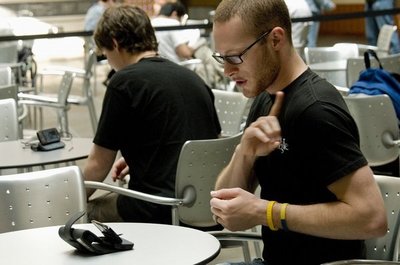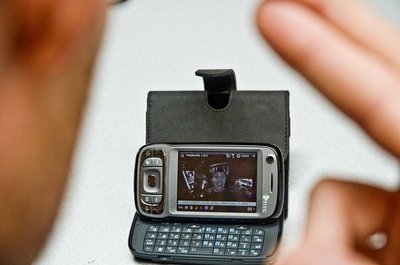August 19, 2010
Deaf, hard-of-hearing students do first test of sign language by cell phone
University of Washington engineers are developing the first device able to transmit American Sign Language over U.S. cellular networks. The tool is just completing its initial field test by participants in a UW summer program for deaf and hard-of-hearing students.
“This is the first study of how deaf people in the United States use mobile video phones,” said project leader Eve Riskin, a UW professor of electrical engineering.
The MobileASL team has been working to optimize compressed video signals for sign language. By increasing image quality around the face and hands, researchers have brought the data rate down to 30 kilobytes per second while still delivering intelligible sign language. MobileASL also uses motion detection to identify whether a person is signing or not, in order to extend the phones’ battery life during video use.
Transmitting sign language as efficiently as possible increases affordability, improves reliability on slower networks and extends battery life, even on devices that might have the capacity to deliver higher quality video.
This summer’s field test is allowing the team to see how people use the tool in their daily lives and what obstacles they encounter. Eleven participants are testing the phones for three weeks. They meet with the research team for interviews and occasionally have survey questions pop up after a call is completed asking about the call quality.
The field test began July 28 and concludes this Wednesday. In the first two and a half weeks of the study, some 200 calls were made with an average call duration of a minute and a half, researchers said. A larger field study will begin this winter.
“We know these phones work in a lab setting, but conditions are different in people’s everyday lives,” Riskin said. “The field study is an important step toward putting this technology into practice.”
Participants in the current field test are students in the UW Summer Academy for Advancing Deaf and Hard of Hearing in Computing. The academy accepts academically gifted deaf and hard-of-hearing students interested in pursuing computing careers. Students spend nine weeks at the UW taking computer programming and animation classes, meeting with deaf and hard-of-hearing role models who already work in computing fields, UW graduate students and visiting local computer software and hardware companies.
Most study participants say texting or e-mail is currently their preferred method for distance communication. Their experiences with the MobileASL phone are, in general, positive.
“It is good for fast communication,” said Tong Song, a Chinese national who is studying at Gallaudet University in Washington, D.C. “Texting sometimes is very slow, because you send the message and you’re not sure that the person is going to get it right away. If you’re using this kind of phone then you’re either able to get in touch with the person or not right away, and you can save a lot of time.”
Josiah Cheslik, a UW undergraduate and past participant in the summer academy who is now a teaching assistant, agreed.
“Texting is for short things, like ‘I’m here,’ or, ‘What do you need at the grocery store?'” he said. “This is like making a real phone call.”
As everyone knows, text-based communication can also lead to mix-ups.
“Sometimes with texting people will be confused about what it really means,” Song said. “With the MobileASL phone people can see each other eye to eye, face to face, and really have better understanding.”
Some students also use video chat on a laptop, home computer or video phone terminal, but none of these existing technologies for transmitting sign language fits in your pocket.
Cheslik recounts that during the study one participant was lost riding a Seattle city bus and the two were able to communicate using MobileASL. The student on the bus described what he was seeing and Cheslik helped him navigate where he wanted to go.
Newly released high-end phones, such as the iPhone 4 and the HTC Evo, offer video conferencing. But users are already running into hitches — broadband companies have blocked the bandwidth-hogging video conferencing from their networks, and are rolling out tiered pricing plans that would charge more to heavy data users.
The UW team estimates that iPhone’s FaceTime video conferencing service uses nearly 10 times the bandwidth of MobileASL. Even after the anticipated release of an iPhone app to transmit sign language, people would need to own an iPhone 4 and be in an area with very fast network speeds in order to use the service. The MobileASL system could be integrated with the iPhone 4, the HTC Evo, or any device that has a video camera on the same side as the screen.
“We want to deliver affordable, reliable ASL on as many devices as possible,” Riskin said. “It’s a question of equal access to mobile communication technology.”
Jessica Tran, a doctoral student in electrical engineering who is running the field study, is experimenting with different compression systems to extend the life of the battery under heavy video use. Electrical engineering doctoral student Jaehong Chon made MobileASL compatible with H.264, an industry standard for video compression. Tressa Johnson, a master’s student in library and information science and a certified ASL interpreter, is studying the phones’ impact on the deaf community.
The MobileASL research is primarily funded by the National Science Foundation, with additional gifts from Sprint Nextel Corp., Sorenson Communications and Microsoft Corp. Collaborators at the UW are Richard Ladner, professor of computer science and engineering, and Jacob Wobbrock, assistant professor in the Information School.
The Summer Academy for Advancing Deaf and Hard of Hearing in Computing is applying for a third round of funding from the National Science Foundation. Additional support for this year’s program came from the Johnson Family Foundation, the Bill and Melinda Gates Foundation, Cray Corp., Oracle Corp., Google Corp. and SignOn Inc.
Tag(s): American Sign Language • College of Engineering • Department of Electrical & Computer Engineering • Eve Riskin • Paul G. Allen School of Computer Science & Engineering • Richard Ladner • Summer Academy for Advancing Deaf and Hard of Hearing in Computing




